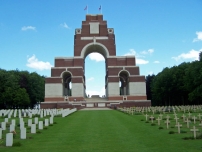| First Name: | William | Last Name: | COALTER | |
|---|---|---|---|---|
| Date of Death: | 01/07/1916 | Lived/Born In: | Limehouse | |
| Rank: | Lance Coporal | Unit: | Royal Inniskilling Fusiliers11 | |
| Memorial Site: | Thiepval Memorial, France | |||
Current Information:Age-33 Enlisted-London
The opening day of the Battle of the Somme 1st July 1916 This was a disastrous day for the British Army in France. Eleven divisions of Fourth Army attacked along a 15 mile front from Maricourt to Serre. Two further divisions of Third Army launched a diversionary attack just to the north of Serre at Gommecourt. For a week beforehand the British artillery pounded the German trenches but the Germans had been there for a long time and they had constructed deep, concrete reinforced shelters beneath their trenches and many survived the bombardment. The troops went over the top at 7.30am but even before they had left their overcrowded trenches, many had been killed or maimed by German artillery. The Germans knew that they were coming. Once in No-Man’s-Land the artillery continued to take its toll and then the machine guns opened up on the advancing British infantry. They fell in their thousands and the attack came to a standstill almost everywhere. Survivors sought cover wherever they could find it and at night they crawled back to their own lines, often dragging a wounded soldier with them. Only in the south were any advances made with the attack on Fricourt and Mametz. Over 19,000 British soldiers were killed on this day, including 2,500 from London. On 1st July, 36th Division, which had been raised in Ulster, attacked in the valley of the River Ancre, just to the north of the imposing Thiepval ridge. Attacking with speed they soon took the German front line, including the strongly fortified Schwaben Redoubt and by 10am some troops had made it to the German second line. But in so doing they over ran their own creeping barrage but even more disastrously the attacking divisions on either side had not kept up with them and 36th Division found themselves pinned down in a narrow salient and coming under attack on 3 sides. From this parlous position they kept up a resistance all day but an enemy counter attack at 10pm, by which time they were running critically short of ammunition, forced them to fall back, almost to their starting point. 109 Brigade attacked with 9th Royal Inniskilling Fusiliers and 10th Royal Inniskilling Fusiliers with 11th Royal Inniskilling Fusiliers and 14th Royal Irish Rifles in support. The leading waves carried all before them getting to the enemy front line just before the Germans emerged. They had but a few casualties whilst taking the front and support lines but nearing the reserve trench five hundred yards further on, machine guns in Thiepval, previously occupied with 32nd Division, were turned on them and the losses started to mount. But the advance continued and by 8am the reserve trench and the front face of the Schwaben redoubt had been entered. Many Germans came out of deep dug-outs and surrendered and four hundred prisoners were sent back. By 8.30am despite increased flank fire from Thiepval and St Pierre Divion, the advance had reached the Moquet Switch and the eastern salient of the Schwaben Redoubt where the Hansa line ran into it. They had advanced for one mile from Thiepval Wood but by now they were isolated and eventually, the few survivors had to fall back. One of the casualties suffered by 11th Royal Inniskilling Fusiliers was William Coalter. |
||||
| « Back to Search Results | ||||
| If you think any of the information shown here is incorrect, Click Here to submit your amends and comments | ||||




